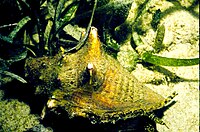
Photo from wikipedia
The goals of this study were to evaluate growth, development, and calcification process of veligers of Strombus gigas grown in natural conditions in mesocosm versus laboratory conditions. In this study,… Click to show full abstract
The goals of this study were to evaluate growth, development, and calcification process of veligers of Strombus gigas grown in natural conditions in mesocosm versus laboratory conditions. In this study, larvae bred in mesocosm conditions had a good growth rate (33.3±12.40 μm.day−1) when fed with natural phytoplankton in natural flowing seawater versus a lower growth rate of 8.8±5.20 μm.day−1 for larvae reared in laboratory conditions and fed with a monoalgal diet of Nannochloropsis oculata. Physicochemical parameters did not explain the difference on larval growth in both culture systems according to the principal component analysis done. Raman microspectrometry carried out on conch larvae grown in mesocosm and lab conditions allowed us to emphasize the biosynthesis of calcium carbonate species and their structure type evolution (amorphous, aragonite, or calcite structure) as a function of the breeding time by detecting and identifying in the spectra the characteristic Raman bands of CO3 chemical groups and lattice vibrations. This analytical method seems to indicate that crystalline CaCO3 structures are not detected in the recorded spectra on larvae reared in laboratory conditions during the early stages of the shell construction of 1 to 8 days. For this reason, light and current flow have also been considered in the discussion that can help to explain the differences found in this study. Contrarily, the Raman spectra acquired on larvae grown in mesocosms exhibit characteristic bands of aragonite (CO3 double peak at 697–701 cm−1 and lattice vibrations at 170 and 220 cm−1) from the third day of breeding. The best shell growth and shell calcification pointed out in larvae grown in mesocosm compared to laboratory conditions are probably due to the nutrient amounts present in the food available in mesocosm.
Journal Title: Aquaculture International
Year Published: 2021
Link to full text (if available)
Share on Social Media: Sign Up to like & get
recommendations!